米什金货币金融学(英文)PPT (11)
- 格式:ppt
- 大小:3.06 MB
- 文档页数:15
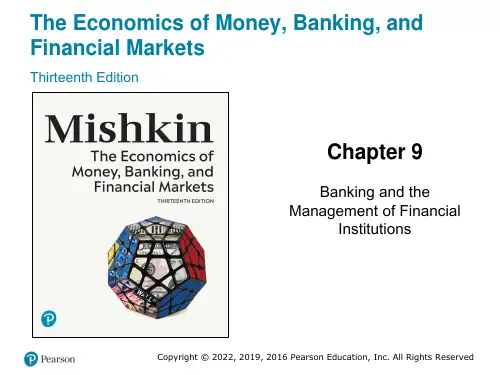
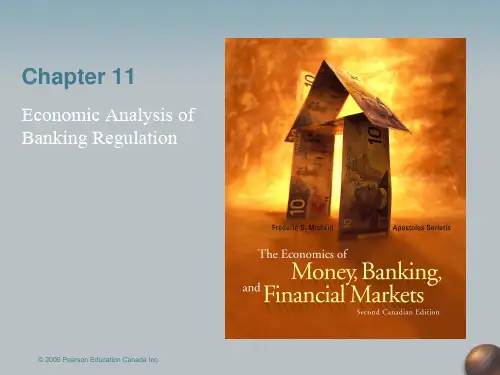
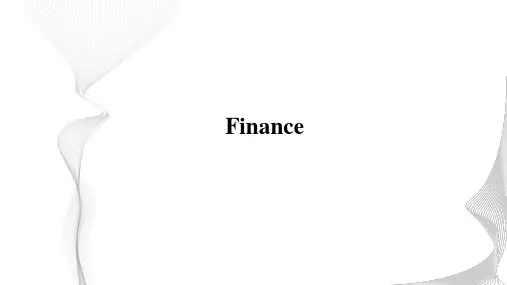
FinanceChapter1 IntroductionWhy Study Money, Banking, and Financial Markets An Overview of the Financial SystemWhat Is Money?Lecture 1Why Study Money, Banking, and Financial Markets?•Course Overview•Why Study Financial Markets?•Why Study Financial Institutions and Banking?•Why Study Money and Monetary Policy?Learning Objectives:How to construct a preliminary financial knowledge system Types of financial marketsTypes of financial institutionsHow the central bank implement monetary policyWhat is monetary theoryPart 1Why Study Financial Markets?1.1 Financial MarketsFinancial Markets (P2):Markets in which funds are transferred from people who have an excess of available funds to people who have a shortage.金融市场:资金从那些可用资金过剩的人转移到资金短缺的人的市场。
Why study financial markets?•Channel funds from savers to borrowers, thereby promoting economic efficiency•Affect personal wealth and behavior of business firms1.2 The Bond Market and Interest RatesBond (P3) is a debt security that promises to make periodic payments for a specified period of time.债券:是一种债务性证券,承诺在一个特定时间段内定期支付。
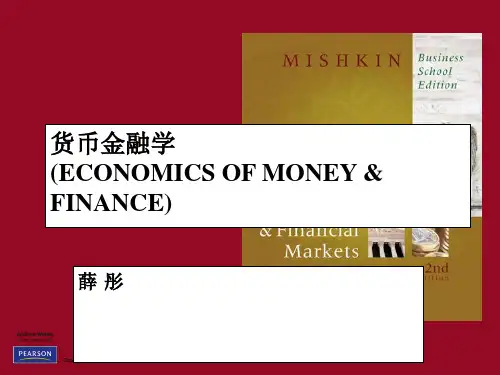
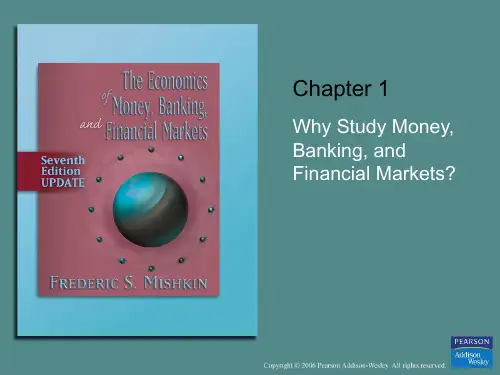
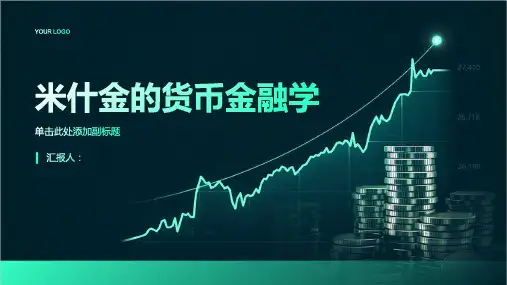

FinanceLecture 2An Overview of the Financial System I•Function of Financial Markets •Structure of Financial Markets •Financial Market Instruments •Internationalization of Financial MarketsLearning ObjectivesCompare direct and indirect finance.Identify the structure and components of financial markets. Describe different types of financial market instruments.Recognize the international dimensions of financial markets.Part 1Function of Financial Markets1.1 Financial MarketsFinancial Markets (P2):Markets in which funds are transferred from people who have an excess of available funds to people who have a shortage.金融市场:资金从那些可用资金过剩的人转移到资金短缺的人的市场。
1.2 Direct FinanceIn direct finance (P23), borrowers borrow funds directly from lenders in financial markets by selling the lenders securities (also called financial instruments).在直接融资中,借款人通过在金融市场出售证券(也称为金融工具),直接从贷款人手中借入资金。


FinanceChapter2 Financial MarketsInterest Rates and Calculation of Interest RatesThe Behavior of Interest RatesThe Risk and Term Structure of Interest RatesThe Stock MarketTheory of Rational Expectations, and the Efficient Market HypothesisLecture 4Interest Rates and Calculation of Interest Rates •Interest Rate and Classification of Interest Rate •Simple and Compound Interest Rate •Present Value•Yield to Maturity and Its Calculation•The Distinction Between Interest Rates And ReturnsLearning ObjectivesCalculate the present value of future cash flows and the yield to maturity on the four types of credit market instruments.Recognize the distinctions among yield to maturity, current yield, rate of return, and rate of capital gain.Interpret the distinction between real and nominal interest rates.Part 1Interest Rate and Classification of Interest Rate1.1 Interest RateInterest rate (P3) is the cost of borrowing or the price paid for the rental of funds.利率是借款的成本或为借入资金支付的价格。
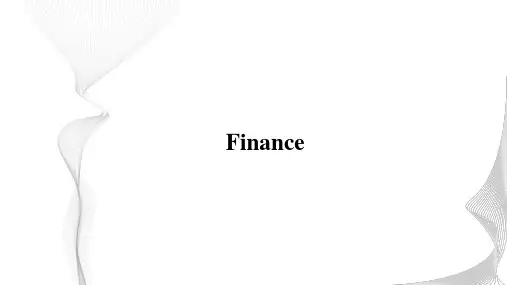
FinanceChapter2 Financial MarketsInterest Rates and Calculation of Interest RatesThe Behavior of Interest RatesThe Risk and Term Structure of Interest RatesThe Stock Market, theTheory of Rational Expectations, and the Efficient Market HypothesisLecture 5The Behavior of Interest Rates•Determinants of Asset Demand•Supply and Demand in the Bond Market •Supply And Demand in the Money Market: The Liquidity Preference FrameworkLearning ObjectivesIdentify the factors that affect the demand for assets.Draw the demand and supply curves for the bond market and the money market, identify the equilibrium interest rate.List and describe the factors that affect the equilibrium interest rate in the bond market and the money market.Identify and illustrate the effects on the interest rate of changes in money growth over time.Interest Rate Determination Theory•Asset Demand Theory•Bond Supply and Demand Analysis •Money Supply and Demand Analysis ——(Liquidity Preference Framework)Part 1Determinants of Asset Demand1.1 Determinants of Asset DemandAsset is a piece of property that is a store of value.资产就是具有价值储藏功能的财产Money, bonds, stocks, art, land, houses, farm equipment, and manufacturing machinery are all assets.1.1 Determinants of Asset DemandDeterminants of Asset Demand:•Wealth: total resources owned by the individual, including all assets;•Expected return relative to other assets; (Expected return: the return expected over the next period)•Risk relative to other assets; (Risk: the degree of uncertainty associated with the return)•Liquidity relative to other assets; (Liquidity: the ease and speed with which an asset can be turned into cash)1.2 Theory of Portfolio ChoicePart 2Supply and Demand in the Bond Market2 Supply and Demand in the Bond Market2.1 Demand CurveConsider the demand for one-year discount bonds, which make no coupon payments but pay the owner the $1,000 face value in a year.If the holding period = years to maturity = 1 year, rate of return = interest rateii=RR=FF−PP PPwhere i= interest rate = yield to maturityRR= rate of returnF = face value of the discount bondP = initial purchase price of the discount bond2.1 Demand CurveIf the bond sells for $950, the interest rate and rate of return areii=RR=$1000−$950$950=0.053=5.3%At a price of $900, the interest rate and rate of return areii=RR=$1000−$900$900=0.111=11.1%Each bond price has a corresponding interest rate and expected rate of return2.1 Demand CurveAs predicted by portfolio theory, when the rate of return is higher, with all other economic variables (such as income, expected returns on other assets, risk, and liquidity) held constant, the quantity demanded of these bonds will be higher.根据资产需求的决定因素,当回报率上升时,其他要素不变,资产需求量也随之上升。

FinanceChapter4 Central Banking and the Conduct of Monetary PolicyCentral BanksThe Money Supply ProcessTools of Monetary PolicyThe Conduct of Monetary Policy: Strategy and TacticsLecture 9Central Banks•Central Banks•Business of Central Banks •Structure of Central Banks •Independence of Central BanksLearning ObjectivesRecognize the historical context of the development of central banks.Describe the key features and functions of central banks.Assess the degree of independence of other major central banks around the world.Recognize policy tools.Central Banks1.1 Central Banks (P306)A central bank is a financial institution given privileged control over the production and distribution of money and credit for a nation or a group of nations. In modern economies, the central bank is usually responsible for the formulation of monetary policy and the regulation of member banks.中央银行是一个金融机构,控制对一个国家或国家集团的货币和信贷的生产和分配的特权。
米什金《货币金融学》第十一版关键术语/名词解释第一章1.总收入:一年中生产要素在生产商品与服务得过程中所获得得全部收入。
2.普通股:简称股票,代表持有者对公司得所有权。
股票就是对公司收益与资产得索取权。
3.国内生产总值:一个国家在一年中所生产得所有最终商品与服务得市场价值。
4.总产出:一个国家或地区在一定时期内经济活动中所产生得商品与服务得生产总量。
5.电子金融:信息技术得突飞猛进激发出得新得金融产品,并促进金融服务以电子化设备得方式提供给广大客户。
6.通货膨胀:物价水平得持续上升7.物价总水平:一个经济社会中商品与服务得平均价格8.联邦储备体系(美联储):美国得中央银行,负责本国货币政策得实施9.利率:借款得成本或为借入资金所支付得价格10.通货膨胀率:物价总水平得增长率11.资产:其所有者由于在一定时期内对它们得有效使用、持有或者处置,可以从中获得经济利益得那部分资产。
12.金融危机:金融市场出现混乱,伴随着资产价格得暴跌以及众多金融机构与非金融机构得破产。
13.货币政策:对货币与利率得管理14.银行:吸收存款与发放贷款得金融机构15.金融创新:新得金融产品与服务得发展16.货币理论:该理论将货币数量得变动与货币政策与经济活动与通货膨胀联系起来,展现了货币供给与货币政策就是如何作用于总产出得。
17.债券:债务证券,它承诺在一个特定时间段中进行定期支付。
18.金融中介:从储蓄者手中吸收资金,并向需要资金得企业或个人提供贷款。
19.货币:在商品与服务支付以及债务偿还中被广泛接受得东西。
20.预算赤字:在一个特定得时间段中政府支出超过税收收入得差额。
21.预算盈余:在一个特定得时间段中税收收入超过政府支出得差额。
22.金融市场:以金融资产为交易对象而形成得供求关系及其机制得总与。
在这个市场中,资金从那些拥有闲置货币得人手中转移到资金短缺得人手中。
23.经济衰退:总产出下降得时期24.财政政策:有关政府支出与税收得决策25.证券:对发行人未来收入与资产得索取权26.经济周期:经济总产出得上升与下降运动27.外汇市场:货币兑换得场所,资金跨国转移得中介市场28.汇率:用其她国家货币表示得一国货币得价格29.失业率:可供雇佣得劳动力中未就业得比例第二章1.逆向选择:在交易之前由于信息不对称所导致得问题(金融市场上就是指那些最可能造成不利(逆向)后果即制造信贷风险得潜在借款人往往就是那些最积极寻求贷款并且最可能获取贷款得人)。
FinanceChapter2 Financial MarketsInterest Rates and Calculation of Interest RatesThe Behavior of Interest RatesThe Risk and Term Structure of Interest RatesThe Stock Market, theTheory of Rational Expectations, and the Efficient Market HypothesisLecture 6The Risk and Term Structure of Interest Rates•Risk Structure of Interest Rates•Term Structure of Interest RatesExpectations TheorySegmented Markets TheoryLiquidity Premium and Preferred Habitat TheoriesLearning ObjectivesIdentify and explain the three factors affecting the risk structure of interest rates.List and explain the three theories of why interest rates vary across different maturities.Part 1Risk Structure of Interest RatesOne attribute of a bond that influences its interestrate is its risk of default.Default occurs when the issuer of the bond is unable or unwilling to make interest payments as promised or pay off the face value when the bond matures.债券的违约(default)风险是指债券发行人无法或不愿履行其之前承诺的支付利息或债券到期时偿付面值的义务1.1 Default Risk1.1 Default Risk1.1 Default RiskU.S. Treasury bonds have usually been considered to have no default risk. Bonds like treasury bonds with no default risk are called default-free bonds.美国国债通常被认为不存在违约风险,像这种没有违约风险的债券被称为无违约风险债券(default-free bonds)。